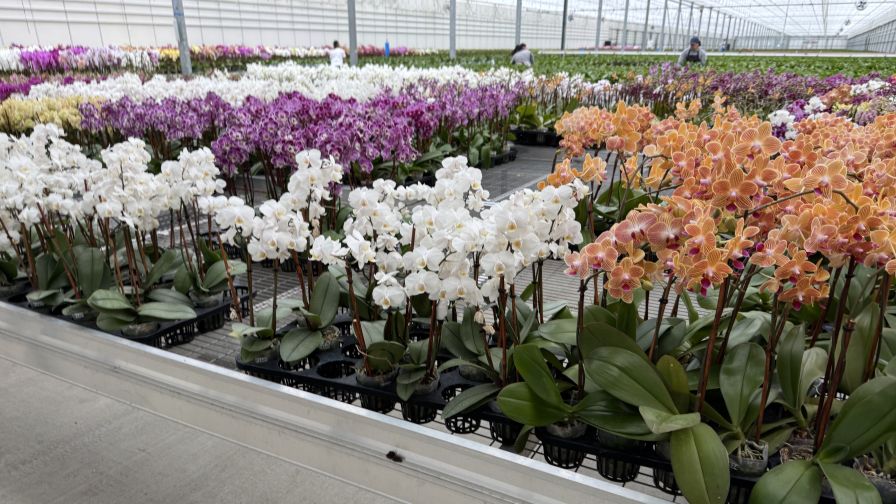
Floricultura is an international breeder of both Orchidaceae and Araceae. In North America, the Floricultura Pacific, a 15-acre greenhouse in Salinas, CA, grows young tropical plants like orchids, anthurium, and spathiphyllum. To maintain optimal environments for its wide range of products, the facility uses automation systems for climate control and operates some systems independently, while others are integrated on a single platform. | ERI with permission from Floricultura Pacific
California is the “Flower Garden” of the U.S., producing 20% of U.S. nursery and floral products. With floriculture sales surpassing $3 billion in 2024, the flower garden just got smarter.
In 2023, the electric utilities — Southern California Edison, Pacific Gas & Electric, and San Diego Gas & Electric — funded a research study involving field demonstrations with energy monitoring in three greenhouses. The Smart Controls for Data-Driven Indoor Agriculture Field Evaluation tests automated, integrated, and intelligent hardware and software in commercial greenhouses to uncover ways to save energy with lighting, HVAC, and irrigation control systems. Energy Resources Integration (ERI) leads a research team with CalNEXT, the statewide electric emerging technology program, and Microclimates, the technology supplier for the field demonstrations.
Orchid Energy
One of the study’s field demonstrations is underway at Floricultura Pacific’s Salinas, CA, greenhouse cultivating phalaenopsis orchids. In December 2024, ERI installed energy monitoring equipment, temperature and humidity sensors, and cameras to observe commercial greenhouse operations and analyze energy use over six months to observe multiple harvest cycles.

A visitor to an ERI facility equipped with energy monitoring equipment. | Energy Resources Integration
Growers globally report that 2025 will be the year of energy efficiency investment. Remote monitoring and control will be a favored tool for businesses to reduce operating costs. In the 2024 Global Controlled Environment Agriculture (CEA) Census, Agritecture shares that “energy efficiency ranked as the No. 1 priority for technology investment across all regions.” Remote monitoring and control ranked No. 2, technology integration ranked No. 3, and data analytics and reporting ranked No. 4.
Integrated Sensing and Control
No matter what systems growers are using right now, monitoring systems like Microclimates can join the team. “Instead of having to rip and replace, growers can build on what they already have. Adding tools like wireless monitoring points gives sharper insights into operations and tracks what really matters so growers can make smarter, data-driven decisions that boost efficiency and sustainability,” says Neda Vaseghi, Co-founder and CEO of Microclimates.
“When everyone can see exactly where and how energy is being used, they can start making changes that cut costs. Utility companies can help by expanding energy monitoring for greenhouses,” Vaseghi adds.
Benefits for Orchid Growers
At Floricultura, integrating wireless monitoring points has enhanced its operational insights, enabling the creation of a detailed map of the facility that monitors real-time data at a granular level from the root zone to above the curtain. Wireless sensors positioned below the plants provide critical data on root zone temperature, while sensors above the canopy offer additional insights into environmental conditions across the greenhouse. This data is seamlessly integrated into Microclimates’ user-friendly visualization platform, allowing for a quick and intuitive map of the entire facility with real-time temperature and humidity levels.

Wireless sensors report conditions across more places in the greenhouse to complement data from existing climate control systems. Energy monitors report energy use from pumps and fans in real-time to the cloud where data is ready for viewing online from any location. | ERI with permission from Floricultura Pacific
Since orchids are a high-value crop, more detailed climate data guides growers to make changes that can improve crop quality, reduce crop degradation and loss, and enhance resource use efficiency. As its team leverages comprehensive data from integrated systems, Floricultura can identify energy consumption patterns and explore strategic changes to reduce costs and improve resource efficiency. As a global leader in orchid production, the company is using these insights to refine its operations, optimize processes, and maintain its commitment to sustainability and excellence.
Lettuce Lessons
More consumers demand fresh, nutritious, tasty, and shelf-stable products each year. The market value of California’s vegetables and herbs grown in CEA facilities went up by 42% between 2017 and 2022, according to USDA data. More than 700 California CEA operators grew $826 million in wholesale produce (vegetables and herbs, tomatoes, fruits and berries, and mushrooms) in greenhouses or vertical farms in 2022.
Greenhouse-grown vegetables and herbs accounted for $526 million of California’s food production that year. Leafy greens are a key contributor to this segment.
The study’s other greenhouse technology demonstrations underway are at a large lettuce greenhouse in Carpinteria, CA. The grower already has advanced control systems and an outdoor weather station. In October 2024, ERI installed Microclimates monitoring hardware and software to enhance operations with energy monitoring. The integrated system shares seamless data from wireless light and climate sensors and energy monitors to give the grower a wealth of new data points and granular vision inside zones of the large houses.
Smart monitoring systems uncover inefficiencies that were previously undetected. With more sensors and more data, the operation can make more data-driven decisions. The system-level energy data for horticultural lighting and fans in propagation and finishing houses are illuminating opportunities for replacing equipment like single-speed circulation fans. Granular monitoring and actionable insights help the grower set new benchmarks for resource efficiency and sustainability in controlled environment agriculture.
An Automated Future
The Smart Controls for Data-Driven Indoor Agriculture Field Evaluation will finish later this year, and a final report will build a case for California electric utilities to launch rebates for climate controls with energy monitoring. The real-world experience at California greenhouse field demonstrations will help utilities shape the best programs for growers for years to come.

